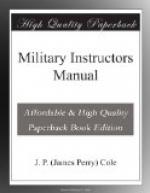F. Non-commissioned officers, after posting sentinels, will report “all is well” or otherwise to the officers on duty.
G. No man will be detailed for a duty in the trench without being given suitable warning of this duty and be informed at which hour he will come on duty.
H. The Company Commander will be responsible for sending any report required by Battalion Headquarters.
2. Sentries.—A. The number of sentry posts required will depend on the assumed propinquity or distance of the enemy, strength of obstacles, ease with which sentry posts can be re-enforced and other local conditions. Normally by day this should be one sentinel for each platoon and at night three double sentinels for each platoon. There must be sentries enough to insure alarm being given promptly in case of attack and that local resistance is sufficient until help can arrive.
B. The next relief will remain within an easy distance of the sentry on post, usually in shelters provided for this purpose.
C. Every sentry is to be regularly posted by a non-commissioned officer who will explain to him his duties and ascertain that the sentry is aware of the position of the section and platoon commanders and of the sentries on either side, and whether there are any patrols or working parties out in front.
D. Every sentinel will report when an officer passes his post, “All is well,” or otherwise.
E. Every sentinel by day will be provided with a head-cover to blend with the ground (this may be improvised), and while observing the ground to the front will remain perfectly still. An empty sand bag or some other suitable material may be utilized for this purpose.
3. Patrols.—A. It is the duty of all the troops holding the front lines to establish a command of the ground in front of their parapet up to the enemy’s wire. This can be done by extended and constant patrolling by night and reconnaissance by day so that the ground is thoroughly well known to as large a portion as possible of officers and men and so no enemy can move or remain in his front by night or day without detection. One of the particular duties of these patrols is to observe the condition of the wire entanglements.
B. Every patrol must have definite orders as to its mission; broadly speaking, patrols may be divided into two classes: (1) reconnoitering patrols, (2) fighting patrols.
C. The first duty of reconnoitering patrols is to obtain the information for which they are sent out. They fight only in self-defense or if any especially favorable opportunity arises to inflict loss upon the enemy without prejudice to their mission. They usually consist of two to six men, under an officer or non-commissioned officer.
D. Fighting patrols are sent out for the express purpose of causing loss or damage to the enemies by such means as engaging the enemy’s patrols or working parties, or by raiding saps, listening posts or trenches. For identification purposes they should always endeavor to secure at least one prisoner. Their strength depends upon the resistance they are likely to meet with.




